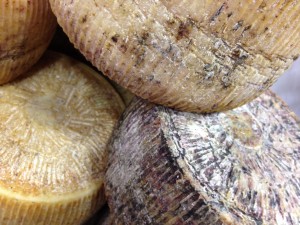Pecorino di Filiano DOP
 Pecorino simply means sheep cheese in Italian, but in reality the term pecorino could never encapsulate the hundreds, maybe thousands of styles of cheese originating from such sweet, shy and fragile animals. Pecorino di Filiano recently received DOP status, which legally defines the cheese for its region, recipe, and historical heritage, and prohibits lesser quality knock-offs from neighboring regions to use the name.
Pecorino simply means sheep cheese in Italian, but in reality the term pecorino could never encapsulate the hundreds, maybe thousands of styles of cheese originating from such sweet, shy and fragile animals. Pecorino di Filiano recently received DOP status, which legally defines the cheese for its region, recipe, and historical heritage, and prohibits lesser quality knock-offs from neighboring regions to use the name.
Pecorino di Filiano is made with the fresh raw sheep milk from the province of Potenza in northern Basilicata (the instep of the heel of Italy). Although recently awarded DOP status in 2007, Pecorino di Filiano has been made for centuries. Unique to Pecorino di Filiano is the method of forcefully pressing the cheese curd into the woven basket molds by hand described as pasta pressato, or pressed curd. This lo-tech process yields a soft-textured firm cheese, not as firm and uniform as Parmesan can be. Another unique production method is stufatura, or heating the cheese in the remaining whey in the cheese vat at a high temperature for a few minutes to extract excess moisture. Again, this allows the cheese to retain a light and flaky texture.
Once formed, the wheels are salt brined for 3 days before aging at least 6 months. Early in the maturation process the wheels are washed with red wine vinegar and olive oil. The vinegar detracts aggressive mold growth, while the olive oil retains moisture and gives a nice golden glow to the exterior. Although made year round, we only receive wheels from spring and summer when the sheep eat fresh grass.
Visually Pecorino di Filiano is a stunner – the basket weave rind is striped with dark wine vinegar stains throughout its glowing golden Mediterranean skin. The aroma reflects the months in the cellar, with earthy sheepy lanolin notes. Slicing into the cheese you’ll find it is firm but not hard, yielding a few flakes and crumbles. The flavors are tart and salty, making your mouth wake up and ask for a glass of wine. After a few moments you’re hit with layers of brown butter, toasted hazelnuts, and fresh hay. Deeper on the palate, you’ll find slate-y characters reflecting the volcanic soil of the mountainous region. The texture is flaky and just a bit chewy.
The bright and salty flavor welcomes a juicy red wine – our Tuscan Fubbiano from Lucca comes to mind for it’s bright cherry flavor, as does a great Priorat for its minerally texture and dark fruit characteristics.
On Thursday, January 24th we’re hosting Giovanni Samela from the Pecorino di Filiano DOP to Cheese Plus for a special tasting and discussion.

